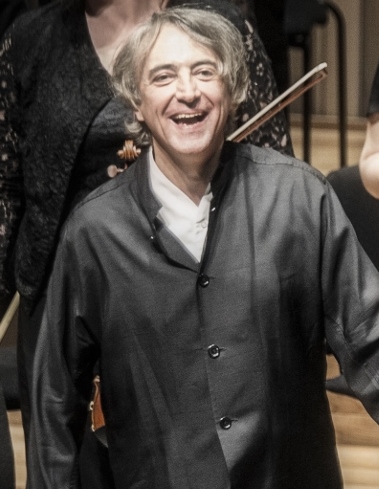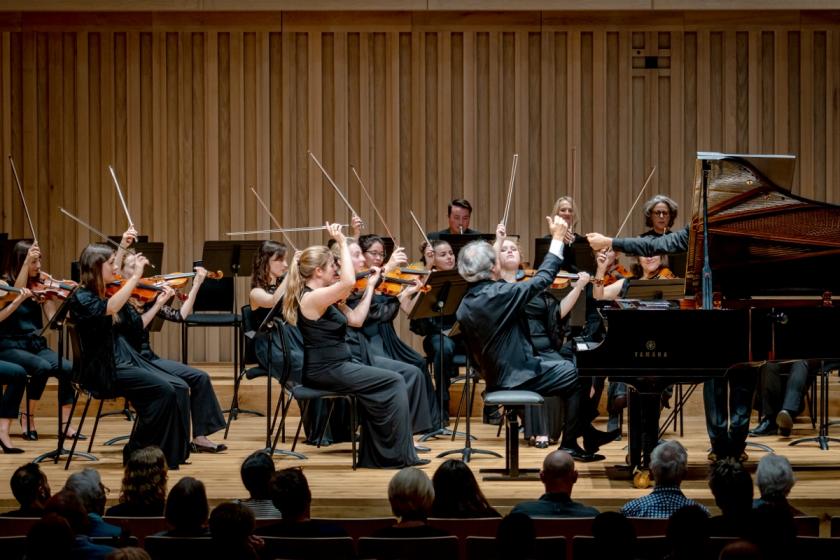It was very much the formula as before, as Jean-Efflam Bavouzet and Gábor Takács-Nagy moved their edition of the Mozart piano concertos a step closer to completion with Nos. 11, 12 and 13.
That formula has served them well in the past: it’s not “authentic” – Bavouzet plays a Yamaha grand, after all, and the musicians of Manchester Camerata play on modern instruments – but it’s certainly historically informed, as well as a delight to listen to.
Their Chandos recordings of this “Mozart, made in Manchester” set are popping out steadily and earning high praise, and on this occasion, tackling the three concertos that were written to stake Mozart’s claim to attention in Vienna soon after he arrived there, the spirit of the age (the early 1780s) was almost tangible. The delicate illuminations of “sensibility” were still very much a watchword in musical expression, but the early rays of rich Romantic sunlight were also beginning to dawn.
And you could also enjoy genteel jollification on some occasions, one such being the debut of the Singspiel The Abduction from the Seraglio (in 1782), whose overture was the hors d’oeuvre to this three-course menu. The Mozart-Manchester project includes recording all the Mozart opera overtures as well as the piano concertos, and this one began Saturday’s concert, complete with triangle, cymbals and Jingling Johnnie to create the true “Turkish music” noise. Gábor Takács-Nagy found more in it than just sound effects, though, with a pleasant skipping tempo for its main theme and neatly controlled string and oboe articulation.
The complete Abduction may have contained “an awful lot of music”, in the view of enlightened Emperor Joseph the Second, but we know he deigned to listen to at least one of the three piano concertos of this set twice over, so it must have done some good.
The first of them, K413 or No. 11, is one on its own in having both outer movements in triple time, but the dancing pulse and delicious hesitations brought to its first movement by Takács-Nagy, echoed by Bavouzet, were immediately appealing, while the tenderness of the slow movement and its sorrowful appoggiature tugged at the heartstrings. The finale sounds like a Minuet, and conductor and soloist made nicely pointed contrasts between the laid-back, almost naïve main theme and its lively episodes. Bavouzet’s playing of the cadenzas was both virtuosic and animated by proto-Romantic feeling.
 K414, or No. 12, is known particularly for its slow movement, which quotes almost precisely a theme by Johann Christian (the “London”) Bach, Mozart’s exemplar and inspiration in his earlier years, who had died not long before the concerto was written. In truth the movement sounds like an hommage, not a memorial nor yet a pastiche, with its elegiacally undulating string figuration, and Bavouzet (pictured left) brought a feeling almost of impromptu to its lead-in to the theme’s repeat. His playing in the first movement’s Fantasy was dramatic, and the finale likewise caught fire in its last pages. He keeps his use of the sustaining pedal to the very minimum, needing it only to ensure legato in some right-hand melodies in octaves and occasionally to fill out his sound momentarily, so the piano, though obviously having little in common as to timbre with the kind Mozart would have played, reflects his music with enviable purity.
K414, or No. 12, is known particularly for its slow movement, which quotes almost precisely a theme by Johann Christian (the “London”) Bach, Mozart’s exemplar and inspiration in his earlier years, who had died not long before the concerto was written. In truth the movement sounds like an hommage, not a memorial nor yet a pastiche, with its elegiacally undulating string figuration, and Bavouzet (pictured left) brought a feeling almost of impromptu to its lead-in to the theme’s repeat. His playing in the first movement’s Fantasy was dramatic, and the finale likewise caught fire in its last pages. He keeps his use of the sustaining pedal to the very minimum, needing it only to ensure legato in some right-hand melodies in octaves and occasionally to fill out his sound momentarily, so the piano, though obviously having little in common as to timbre with the kind Mozart would have played, reflects his music with enviable purity.
K 415, or No. 13, is one of those solid C major celebrations that Joseph II probably liked to hear (with trumpets and drums added only on the day of the premiere, the better to salute his Imperial presence, according to Gábor Takács-Nagy’s little speech of explanation to Saturday’s audience). But it has its subtleties, too, both in the singing second subject of the opening movement and in the stately sentiment of the central Andante. Bavouzet, with Mozart’s own cadenzas once again to give his imagination scope and keep him on the right stylistic path, enhanced his role with elegance and apt touches at every point.















Add comment